#oldest known map
Explore tagged Tumblr posts
Text
Europe’s Oldest Map: The 4,000-Year-Old Saint-Bélec Slate
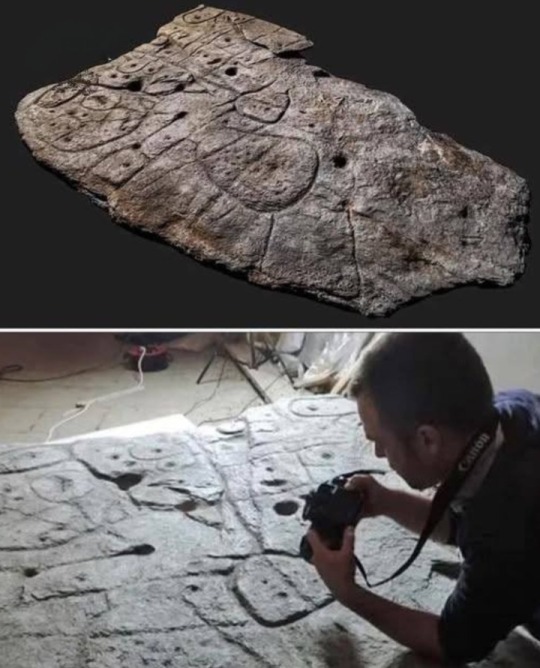
The Saint-Bélec slate, dating back 4,000 years, is considered the oldest known map of Europe.
Discovered over a century ago in northwestern France, the slab remained forgotten until its rediscovery in 2014.
By analyzing local waterways and the positions of ancient architectural sites — especially megaliths — researchers determined that the map represents an area of approximately 630 square kilometers.
This ancient map has already guided scientists to several archaeological discoveries.
The slate itself is massive, weighing between 1.5 and 2 tons, measuring 2 meters in length, 1.5 meters in width, and 15 centimeters thick.
#Saint-Bélec Slate#oldest known map of Europe#oldest known map#map#europe#megaliths#slate#slab#ancient map#archaeological discoveries#archaeology#ancient history#ancient civilizations
8 notes
·
View notes
Text
I accidentally went to the oldest bookstore in the world today
#I’m traveling and I just searched for bookstores on google maps and went to the closest one I found#and they had a guiness world record plaque up about being the oldest operating bookshop in the world#how did I accidentally do that#with my English lit bachelor’s and master’s degree I feel like I should have known about this
7 notes
·
View notes
Text
La Pelle del Diavolo: A Halloween Special

The night air in the hills of Tuscany was thick with the scent of earth and wild herbs, but a chill crept through the wind, slipping from the shadows cast by ancient oaks around the estate. Marco Romano, a seasoned thief, felt the familiar prickle of excitement as he approached the villa.
Dark whispers and superstitions tugged at the edges of his thoughts, but he pushed them aside. Danger was an old friend, and tonight, it had led him to the mysterious Villa Tenebra.
The locals had spoken of the villa’s hidden treasure in hushed tones over dark wine, only daring to mention it in shadowed corners of Florence’s oldest bars. It was a relic of myth, known as the Corpus Noctem, the key to immortal life. Marco had dismissed it as folklore at first, but the lure of such power was impossible to resist.
He had slipped into Villa Tenebra with the help of a map from a cryptic dealer in Florence—a strange man eager to be rid of it. The map was faded and worn, but it revealed something extraordinary: an old smugglers’ passage hidden in the villa’s foundations, built centuries ago to let noblemen move treasures in and out undetected.
The entrance to the passage lay hidden behind a statue in the villa’s overgrown gardens, its base concealing a narrow stone door. With a grunt, Marco pushed it open, revealing a winding staircase descending into the earth. The air was cool and damp, and each step echoed, punctuating the silence with a heavy, ominous beat.

At the bottom, the passage twisted into a dimly lit stone hallway. Shadows flickered on the walls, worn smooth by years of forgotten footsteps. Marco moved forward, his senses sharp, adrenaline building. The air was thick, carrying an old, metallic scent, as though it held memories of things long past.
A few meters down, he found himself in a corridor and saw something he had never encountered—a perfectly sculpted muscle suit that looked like leather, coated in wax, and painted red. The closer he got, the more he felt an odd pull, a magnetic force that made his skin tingle and his pulse intensify.
The suit looked like leather but felt too smooth, too alive. It beckoned to him.

“This is it. The Corpus Noctem. The Flesh of the Night,” he whispered, his voice thick with greed. “The key to youth and eternal life.”
His fingers hovered over the material, and as soon as he touched it, a rush of heat surged through him, like electricity flooding his veins. His fingertips tingled as he traced its sculpted lines. The sensation was intoxicating, almost erotic. His breath quickened, and an unfamiliar hunger stirred deep within him.
With the suit clutched in his arms, he moved quickly down the hall, rounding a corner, his breathing quickening as he felt its warmth intensify. The heat from the suit seemed to throb, mirroring his own pulse, sending waves of anticipation rippling through him.
He knew he couldn’t wait any longer—he needed it on his body, needed to feel it enveloping him.

Setting the suit down, he hurriedly removed his clothes, pulling off his sleek, dark outfit and kicking off his boots. His legs trembled as he reached for the red muscle suit once more, pressing himself against it and feeling heat spread through his body.
He removed his pants, standing completely naked before the suit, savoring the rich red sheen of the leather.
Without hesitation, he began to put it on. The moment it touched his skin, a wave of pleasure and power flooded his senses.
As he slid the suit further up his leg, he felt an incredible tightness around his calf, a strange, thrilling tension as though the suit were pulling at his muscles. And then, to his astonishment, he felt his calf muscle expand, swelling against the material as though infused with newfound strength.
He continued, slipping his other leg in, feeling the suit tighten around his thighs. The same sensation of growth surged through him, his quads and hamstrings expanding, hardening, becoming thicker, stronger.
Marco’s hands trembled as he pulled the suit up over his hips, feeling the snug embrace of the material. He slipped his arms into the sleeves, and as the suit enveloped his torso, a wave of heat exploded through his chest and back.

He watched in awe as his pecs rose, filling out, becoming solid and powerful, each muscle now perfectly defined. His shoulders broadened, the suit tightening around them, forcing them to grow, to harden, until they were as strong as stone.
His arousal surged as he ran his hands down to the calves and then up to the chest, pressing his palm against the sculpted abdomen. It felt perfect—hard, tight, like a muscular man was inside.
Eyes closed, he traced his hands over the biceps and around to the triceps, savoring every sensation.
“You shouldn’t have touched that.”
The thief spun around. An old man stood in the hallway, his silver hair gleaming in the dim light. On his right hand, a tarnished silver ring caught the faint glow, intricate symbols etched into its surface.

His eyes, sharp and full of something the thief couldn’t quite place, bore into him. The air between them crackled with tension.
“This is your treasure, old man?” the thief sneered, masking the tremor in his voice.
The old man stepped forward, his lips curling into a smile that didn’t reach his eyes. “Treasure? No… it’s a curse. You should strip it off and leave while you still can. That suit… The Corpus Noctem… was never meant to be worn by anyone who values their soul.”
The thief chuckled darkly, reveling in the waves of pleasure and power coursing through him as the suit clung tighter, molding to his body like a second skin. “You’re just trying to scare me. It’s mine now.”

But then, something shifted. The warmth he’d felt before began to change, becoming suffocating, as though the suit itself was tightening around him, digging deeper into his flesh.
The initial rush of pleasure twisted into something unbearable, a heat that clawed at him from within.
His chest heaved as panic seized him. “What… what is happening?”
The old man’s gaze was steely, his voice soft yet filled with grim satisfaction. “You wanted to own the suit, to wield its power. But now, it owns you.”
The thief’s hands flew to the suit, trying to rip it off, but the material wouldn’t budge. Panic clawed at him as he realized the truth—this wasn’t just a myth or legend. This was real, and he had fallen for its trap.
“The suit was crafted centuries ago,” the old man continued, his voice soft yet laden with dark knowledge. “A coven of sorcerers, desperate for immortality, summoned an ancient demon—the Harrower of Flesh—who bound its essence into the hollow skin of a man, creating the Corpus Noctem. Whoever wore it would gain eternal youth and beauty, but at a cost: for each year they lived, they’d need to drain another’s essence, leaving behind a lifeless skinsuit. To bypass this, the wearer must cloak themselves in the flesh of another soul—only by donning this skin over the Corpus Noctem can one remain whole.”

The thief’s vision blurred as the suit constricted around him, merging deeper into his skin. His body tingled with a sensation that was equal parts pleasure and terror. It felt as if the suit were feeding on him, consuming his very essence.
The old man’s frail form shifted, and with deliberate slowness, he raised his hands to his face. He pulled it off, revealing a lifelike mask, and beneath it, a strikingly youthful, handsome face emerged—features sharp, jawline strong, eyes dark and piercing. Smirking, he removed his clothes piece by piece, casting off the disguise of age.

As the last layer fell, the old, fragile illusion was gone, replaced by a chiseled, muscular figure that looked as if it had been carved from marble. His back straightened, shoulders broad, and every inch of him radiated a powerful, youthful energy.
“You see, I was once like you,” the man said, his voice now rich and powerful. “I, too, was lured by the suit’s promises. But unlike you, I learned its secrets and made it my own. I’ve lived for centuries, wearing this skin, draining life from those foolish enough to fall into its grasp.”
The thief stumbled back, his body no longer his own. The suit tightened again, and he felt his skin loosen, as if separating from his bones, becoming pliable and empty. He was now little more than an outer shell waiting to be filled.
“You’ll be perfect,” the man murmured with a predatory smile. “I’ve been needing a new face. And your body… it will serve me well.”

The man reached down, his fingers trailing over the thief’s hollowed form, savoring the warmth and fresh pliability. He lifted the emptied skin carefully, feeling its readiness to be inhabited. Pausing, he slid a tarnished silver ring from his finger and set it gently on the floor beside him, a faint smile crossing his lips, as if the gesture held private, ritualistic meaning.
With a sigh of satisfaction, he began donning the suit, the thief’s former identity slipping over him like a glove. The skin conformed to him, tightening and sealing with a sensation that sent shivers through him—a seductive merging of flesh and power.
He ran his hands over his new form, relishing the strength beneath his fingers. This body was everything he’d hoped for—youthful, strong, and ready to endure another century. He reached down, rubbing his hands over Marco's abs, feeling the muscles tense beneath his touch. His hands drifted lower, gripping Marco's cock, heat radiating from it. Wrapping his hand around the shaft, he began to stroke.
“Do you like it?” he asked himself with a smile.
He began to laugh as he continued stroking, feeling Marco grow harder. On the verge of climax, he still sensed remnants of Marco's essence, and his smile grew even wider. Reaching up, he massaged his new face.
But he wasn’t done. He turned to the Corpus Noctem, lying on the floor like a crimson shadow. With practiced ease, he slipped it on, layer by layer, feeling it fuse with his stolen body, amplifying his strength, fortifying every fiber. The suit melded seamlessly, completing his transformation.
Reaching down, he retrieved the silver ring from the floor and slid it back onto his finger, a final touch that signified the bond. He looked into the grand mirror, admiring the flawless reflection. Turning sharply, he traced a hand along his new jawline, savoring the unfamiliar yet perfectly familiar contours. The face of a man he had consumed, a youth he had stolen, now belonged to him entirely.

With a slow exhale, he ran his hands over his abs, savoring each hard, sculpted ridge beneath his fingertips. The suit hugged every contour perfectly, every muscle honed, every line exact.
“Magnificent,” he whispered, his voice low with satisfaction, echoing through the empty hall like a dark promise. Only his faint laughter remained, drifting through Villa Tenebra’s silent halls, waiting for the next soul to fall prey to the Corpus Noctem.
--- ✧ ✧ ✧ ✧ ✧ ✧ ✧ ---
Would you like to expand this dark universe? Follow me to explore more content and updates: https://linktr.ee/mysteroca
#male bodysuit#male body transformation#male body suit#male skinsuit#male body swap#male bodyswap#male transformation#male shapeshift#male disguise#male impersonation
172 notes
·
View notes
Text



about caldara— 490 A.B.
above is a general map that i made of my continent. give or take some details because i didn’t want it to get too cluttered oops. hopefully it serves as a good visual for my explanations of each region and its key city! anywho longgg ass post incoming!

NYSSAROS is the capital of the continent and crown jewel of house vangaros. it sits in the flatter heartland of eryndor which is the largest region on the continent. it is important to note that nyssaros is located where its most strategic but not where it is most safe. it’s connected to many borders but difficult to access or pass through all willy nilly. the capital sits where we, as the crown family, can see everything, steal anything and escape anything. it’s a very active city. as for looks, the whole city glitters and dazzles you in a way you can only dream. polished gold inlay is worked into the streets themselves. buildings are structured in tiers, with the higher you go, the closer you get to nobility. spires and domes dominate the skyline, crafted in a blend of obsidian, marble, and goldenstone. balconies overflow with vines and flowers, braziers line every street, and the palace is built directly atop a shallow rise. my family has held nyssaros for nearly 500 years, since the first raqiros dova established the capital post-binding. no one’s ever challenged our right to it either. we built this city.
TALVARIS is a wild thing. it’s overgrown and very old. clinging to the base of the veil peaks, where stone meets trunks of trees and dragons still pass overhead. the architecture here blends right into the land. houses are carved into cliffsides or built around massive trees, with rope bridges and winding stone steps acting as public paths. it’s governed by three houses: maroveth, vangaros, and rhadanis, each with their own domain within the city. the oldest temple, dedicated to the first flame, rests in the rhadanis-controlled quarter. maroveth’s section is known for its mineral forges and glasswork studios, while vangaros oversees the watchtowers and sky bridges. it’s one of the few cities where control is shared and not tested.
RAVENA, in the north of vysara, is unlike anywhere else in caldara. it’s built on stilts above the marshes, and its waterways are its roads. instead of streets, there are canals and bridges. houses here are tall and narrow, often with open lower levels to avoid flooding, and their rooftops are tiered like the petals of a lotus flower. it’s a holy city, controlled solely by house rhadanis for the last six centuries, and is home to the oracle temples and the drowned archives. you can only imagine how well secrets flow through this place.
ILLORIA is just off the mainland on the island of wynsereth and it’s considered the most serene (and slow moving) of all the major cities. the buildings are sculpted from pale stone and dark wood, with gilded lattices and canopies. every home and hall has a garden or water feature, and the roads are quiet, winding, and lined with flowering trees. house davenar has ruled here for over 600 years—similar to rhadanis with ravena. they’re the old money, old faith, old legacy of this world. while rhadanis may be known as the “first” of the great houses, davenar is the reason “great” even had to be listed to begin with. illorian trees have the sweetest fruits and the richest soils. when nobles retire or retreat, they come here. and—as a bonus—the surrounding lands of wynsereth are literally known as “the golden forests” due to the sheer abundance of gold and other precious metals found here. it’s truly a testament to davenar’s respect that the lands haven’t been excavated into oblivion yet.
THALORN is a forge city built in a goddamn caldera. the region of valdorra is volcanic, and thalorn was carved out of what remained after one of the last great eruptions. tunnels run beneath the city, used to avoid dragons since valdorra is their primary hunting grounds. it’s hot, always, and that’s saying a lot considering caldara is a continent of eternal summer pretty much. but caldarans are smart and not easily deterred! the stone buildings are vented and hollow, built to withstand intense heat. black glass, copper tiles, and a smidgen of smoke stained gold give thalorn its iconic look. house maroveth controls the region and has for about 200 years, ever since the last ruling line died out in a lavaflow (oops).
RHALENMOOR is the capital of house venakar, and it shows. it’s built in the fertile yet drier plains of nysara. the golden fields stretch in every direction and the city rises out of the land like a fortress of lush abundance. clay brick walls, green domed halls, and sprawling market squares aplenty. there’s irrigation channels that double as ritual spaces, and the storage houses are adorned with carvings that honor seed and harvest. venakar’s had it for multiple generations and they don’t share well. anyone who wants to eat in caldara knows to stay in venakar’s good graces. while a relatively young house, they’re surprisingly nifty—and ambitious which could read badly for house rhadanis whom shares territory with them.
AVENTHAL is a fortress first, city second. it belongs to house tharavos, who took control after a royal decree roughly 180 years ago. it used to be a torvane port, but was deemed too inland and got reassigned. it’s all stone and steel—walls within walls, like an inescapable maze. the streets are tight, but the surveillance is tighter. there are more whisperers here per capita than anywhere else in caldara because aventhal is where they train before they’re sent off to other regions. regular ole people live here, yes, but house tharavos has a thing about orphans. and there’s an abnormally high rate of orphans that end up in aventhal than anywhere else… they gotta find someway to survive, right? so they get really good at two things: hide and listen. just to then line their pockets with tharavos gold. that’s how aventhal became a city that never sleeps, but stalks.
KHALMAR, in othalar, is carved directly into the mountain. it looks impenetrable because it is. built like a vertical city, its homes and barracks cling to stone cliffs, connected by narrow staircases, lifts, and winding tunnels. valdryn has ruled here for over 300 years, ever since they won the southern wars and claimed it as their prize. firelight glows from within the rock faces at night, and the forges never go cold. it’s a warrior city, plain and simple. also the hub of many of our military operations. the region is directly under valdorra which makes for easy access to dragons and luckily (or unluckily, depending on which house you’re in) valdryn has an abundance of dragon power thanks to the events that took place in 340 A.B. they’ve accumulated six dragons despite not being an original bloodline to claim them. some whispers say house valdryn one day plans to overthrow vangaros and claim nyssaros for themselves…
VELMARRA is house torvane’s sea-wrapped gem. it curves around the coast like a blade, with harbor spires that double as storm towers. it’s not just a port—it’s a city raised against the deep. every structure is built to bend with the wind: narrow towers reinforced with stone that’s stood the test of time and obsidian anchors that moor the city to the earth itself. the buildings gleam in blues, pewter, and pale gold which is the one similarity velmarra shares with the rest of the great cities. sea monsters are carved into the walls like warnings, while prayers against drowning can be found in all of the temples. torvane has overseen velmarra longer than any other house has ruled a city singlehandedly. it has been their sworn duty since the beginning of, perhaps, time itself. they don’t just run trade. they guard caldara from what moves in the water: horrors only born from the tide like leviathans and sea wraiths that destroy ships without a second thought. without torvane, the southern coastline would be chaos. every storm is a test, especially in the harsher months, and every return to port is a small war won. every street leads to the sea. even the fishers carry knives. velmarra isn’t gentle. it’s not a beach town overlooking a calm ocean. it’s a siren’s song that drags you into your own blissful death.
#shaysplanet#shiftblr#shifting blog#reality shifting#shifting diary#shifting community#desired reality#shays multiverse
76 notes
·
View notes
Text
On the Watchtower, Batman, Wonder Woman, and Raven had completely taken over one of the smaller meeting rooms. No one was allowed in and all the cameras for the room had been turned off. Wonder Woman and Raven had said it was overkill, but Batman had insisted it was necessary. They didn’t argue, so the room stayed a black space on surveillance.
The entire table had been covered by information pertaining to the Ghost Investigation Ward and the Department of Metahuman Affairs. Information which was getting shadier and shadier by the paragraph. Information that was giving them more insight as to who Phantom was.
The oldest files that even mentioned the G.I.W also mentioned a young hero by the name Phantom. They describe Phantom as a villain, fighting tooth-and-nail, destroying everything in his path and attacking anyone within sight. As the files go on, the more detailed they become. Describing fights, property damage, powers, attacks, and even more ghosts. There’s also a significant number of mentions of some place called the Ghost Zone, later corrected to the Infinite Realms.
The more they read, the more horrified the heroes became. In all of these files, Phantom and the Realms Beings are described as monsters to be captured, studied, and eradicated. It wasn’t right.
Cloning technology was another thing they came across, though all of the papers were under the name Vlad Masters. Failed clones, destabilization, and the templates that were used: A fourteen year old boy named Daniel Fenton and hero Phantom. Two names and faces that Batman knew as Danny ‘Phantom’ Nightingale.
Vlad Masters apparently worked alongside the G.I.W while he lived as Mayor of Amity Park, Illinois. A place that no longer exists. Godfather to the very boy he’d been trying to clone. When he died, a disease from his college days catching up with him, all his research had gone to the G.I.W, except for one thing.
There was an empty file simply titled Ghost Portal. Although it was empty, the file had been corrupted, releasing a virus that Batman managed to catch and isolate quickly enough so that it didn’t disturb anything.
Batman would bet anything that whatever had been in that file was a lot more detailed than the simple picture Phantom had drawn up for them.
“How much do you think they had on the portal?” Wonder Woman asked.
Raven hummed. “Probably a lot more than any of us would like. Especially if that Vlad guy from the other files had any part in it.”
“Indeed,” Batman agreed, “He kept quite the detailed notes.”
Wonder Woman picked up a printed file full of Phantom’s escapades on paper, one that she’d flipped through at least a dozen times. “It’s horrible what he’s been through.”
“There’s not gonna be any more information in there,” Raven said as she gently took the folder from the demigod’s hands, “Can you find anything we haven’t poured over a million times?”
No one said anything for a few minutes, the sound of Batman’s keyboard being the only real noise for a while.Then, he said, “Nothing that we don’t already know.”
“So let’s go over it again.”
Suppressing a groan, Raven folded her legs under her and let her magic float her over to the table. The two adults walked.
Batman had a map projected onto the whiteboard. Using a marker, he marked out where they could guess Amity Park once was. “Let’s start here.”
“In the town that doesn’t exist?”
“Yes.”
Wonder Woman nodded. “How did it disappear?”
Raven rifled through the papers again. “It faded out over time. It was a tourist trap for a while, but it eventually lost its business.”
“Why?” Batman asked.
Finding the paper she wanted in the folder on Danny Fenton, somewhere in Vlad Master’s notes, Raven picked out a single sided piece of paper. “It was known as the most haunted city in America. After a while, apparently, ghosts just stopped showing up. Phantom stopped appearing and the tourists stopped coming. I assume the locals all moved out. After that, the city was absorbed by the local wildlife.”
Batman hummed. “There’s no ruins.”
Wonder Woman blinked, also taking a paper from the folder Raven had opened, this time a picture. “But there is, see?”
The picture was, indeed, of the ruins of a small city. No skyscrapers, but several businesses, lots of homes, a mall, parking lots, schools, and parks.
The map on the board zoomed out to show all of Illinois. “There’s no ruins like that anywhere in the state.” It zoomed out again. “There’s no ruins like that anywhere in the country.”
“You check the rest of the world?” Raven snarked quietly.
“Yes,” Batman said, “There’s none.”
“They have to be somewhere,” Wonder Woman argued, “Phantom confirmed that he was born and raised on this Earth. There are records of him going back to our estimated time. He himself said he was born in that town. Where could it have gone?”
There was a long pause for another long minute. Then, Batman turned his back to the map and rifled through the papers. When he finally found what he was looking for, he put it on top of the pile for the girls to see before he found his way back to the computer. “The Ghost Investigation Ward was absorbed into the Department of Metahuman Affairs.”
“So?”
“The DMA keeps records of everything, including records from every group that they absorb. Employees, research, experiments, permission, even birthdays.”
“If you can gain access to what they’re doing,” Wonder Woman started.
Raven touched back down, opting to stand again. “We can find every dirty little secret they’re trying to-”
“Done,” Batman said.
“-hide.” Raven finished quietly. “Alright, cool. What’d you find?”
Batman highlighted a few paragraphs, sending them to be projected on the whiteboard instead of the map. He walked over and erased the marker. “Even after being absorbed into an official government entity, everyone working for the G.I.W goes by a letter of the alphabet. The Heads of Department go by the Greek letters, Alph, Beta, and Gamma. In recent years,” the words switched to a picture too similar to the portal Phantom had drawn up for them to be a coincidence, “they’ve begun work on a project called Project Gateway.”
“Phantom’s Portal,” Raven gasped lightly.
Batman nodded. “According to official files, it hasn’t made any headway past sketches from old notes. But, I did find travel logs going to and from Pakistan.”
“What’s in Pakistan?”
“The League of Assassins.” Wonder Woman answered. “They’re working with the League?”
A hum. “Most likely,”
“We need to warn Red!” Raven didn’t quite yell, but it was a near thing.”
Batman shook his head. “Red Robin, Constantine, and Zatanna will be fine. They’re prepared. We need to focus on this.” The slide changed again to experiment logs. Names paired with subject numbers.
“The coma victims.”
“The Anti-Ecto Acts were vetoed before they could become law. However, when the G.I.W was absorbed into the DMA, they were reworded into what we know as Anti Metahuman Laws.”
“Those laws didn’t condone human experimentation!”
“No. But, according to the G.I.W, the people they’re experimenting on aren’t human.”
“I don’t understand,” Raven interrupted, “None of those people went missing. None of them have anything in common. Why them?”
“Not quite,” Batman said, “Within a few miles of each victim’s home, there are rumors of hauntings. Ghosts, unrested spirits, poltergeists, et cetera.”
“They were picked,” Raven asked slowly, “because these people thought they were ghosts?”
“It would seem that way, yes.”
Wonder Woman sighed. “I’ll call Superman and Red Robin. Their teams will need to be made aware.”
Part 27 Part 29
#Enough Caffeine to Kill an Elephant#part 28#dc x dp#raven#batman#wonder woman#sorry it's been so long guys!
65 notes
·
View notes
Text
Cuts made by the Trump administration are threatening the function of a tiny but crucial office within the National Oceanic and Atmospheric Administration that maintains the US’s framework of spatial information: latitudes, longitudes, vertical measurements like elevation, and even measurements of Earth’s gravitational field.
Staff losses at the National Geodetic Survey (NGS), the oldest scientific agency in the US, could further cripple its mission and activities, including a long-awaited project to update the accuracy of these measurements, former employees and experts say. As the world turns more and more toward operations that need precise coordinate systems like the ones NGS provides, the science that underpins this office’s activities, these experts say, is becoming even more crucial.
The work of NGS, says Tim Burch, the executive director of the National Society of Professional Surveyors, “is kind of like oxygen. You don’t know you need it until it’s not there.”
“NOAA remains dedicated to providing timely information, research, and resources that serve the American public and ensure our nation’s environmental and economic resilience,” NOAA spokesperson Alison Gillespie told WIRED in an email when asked about the downsizing of NGS.
NGS was formed in 1807 by Thomas Jefferson, the son of a surveyor and cartographer. Originally called the Survey of the Coast, the organization, led by a young Swiss immigrant named Ferdinand Hassler, was tasked with mapping the coastlines of the new country. Over the next 200 years, its mission expanded to cover the practice of geodesy: the science of calculating the shape of the Earth, its orientation in space, and its gravitational field.
“Hassler understood that before you put pen to paper and make a chart or a map, if you wanted to [know how] things relate accurately one to another, especially if you’re going to do that over a large area like the United States, then you have to have a very strong mathematical foundation to put all these pieces together,” says Dave Doyle, a former chief geodetic surveyor at NGS. “That is, in a very simple way, what the science of geodesy brings to the nation.”
NGS is currently responsible for maintaining and updating what’s known as the National Spatial Reference System, a consistent system of physical coordinates used across federal and local governments, the private sector, and academia. This includes not only latitude and longitude, but also measurements of depth and height as well as calculations around Earth’s gravitational field—crucial mathematics that inform much of the basic infrastructure around us, from constructing bridges to mapping out water and electric lines. NGS also maintains and operates more than 1,700 federally owned satellite receivers across the US, which provide publicly available geospatial information.
While individual surveyors can compare heights and distances in smaller areas, it’s far more difficult to compare mountains thousands of miles from each other, or know exactly how sea level rise may be affecting different areas of the country that have vastly different coastlines. Having a coordinated frame of reference across the entire country—both latitude and longitude as well as depth and height—underpins the accurate positioning of locations across the US in relation to each other, as well as in relation to other geospatial measurement systems across the world.
The Earth is also constantly shifting: the motion of tectonic plates causes latitude and longitude coordinates to slowly move, mandating that they be updated every few decades. In some places—like the coast of Louisiana, where subsidence is causing between 25 to 35 square feet of land loss each year—these shifts manifest much quicker.
“Most people can stand on the beach and see the water and turn around and look at a dune behind them and go: ‘Oh, yeah. That’s about 5 or 6 feet above sea level,’” says Doyle. But when it comes to building things, you need to be able to accurately take measurements at scale. “You have to have some system of heights that is standardized across a large geographic body. I want consistent heights from New York to Maryland so we can build highways, so we can build utility infrastructure. You want to make sure water is always flowing in the appropriate direction.”
The US is currently working with a particularly outdated set of coordinate systems. The current measurements contained in the National Spatial Reference System—including latitude, longitude, and vertical heights, a set of reference systems called datums—were established in the 1980s, shortly after the US launched the world’s first GPS satellites. In the years since those datums were created, increasingly advanced satellite technology has enabled geodesists to more accurately measure the shape and orientation of the Earth, and to better position their measurements. As a result, each point of measurement in the US datums is now, on average, around two meters off from its actual, accurate location. In some locations, it’s even more extreme.
As anyone who has tried to go for a run with a glitchy Garmin watch knows, current GPS technology has limits in terms of on-the-ground precision. For everyday navigation, exact locations aren’t truly necessary—but for a variety of activities, from mapping floodplains to building bridges to measuring sea level rise, every centimeter becomes crucial. Ensuring hyper-accurate location is also becoming increasingly important as more and more industries are building up around automation that relies on precise spatial measurements.
“Do you want to get in an autonomous taxi that is plus or minus two and a half meters going down the road?” says Burch. “I don’t. That is part of the critical piece here: all these systems have to be this tight and this precise moving forward.”
In order to update the US’s datums to be in line with satellite data, land shifts, and accurate measurements of the Earth, staff at NGS were planning on rolling out a long-awaited modernization of the National Spatial Reference System, bringing it into the 21st century and making it easier to update moving forward. Originally scheduled to be completed in 2022, the agency posted a notice in the federal register last fall detailing its updated timeline for rolling out the new datums and associated products in 2025 and 2026.
But three former staffers who left NGS in the past month say this planned rollout may be pushed even farther behind by staff losses, thanks to employees like them who took retirements, left their jobs, or were laid off as part of federal restructuring. According to former staff, NGS was sitting at 174 employees at the start of the year, with staff looking to fill an additional 15 positions to help with rolling out the new datums and educating federal agencies and local governments on their use. Since January 20, the agency has lost nearly a quarter of its staff and has had to freeze planned hiring. (When asked about the accuracy of these numbers, Gillespie, the NOAA spokesperson, told WIRED that the agency has a “long-standing practice not to discuss personnel or internal management matters.”)
The remaining staff are in an “all hands on deck” situation with the rollout, says Brett Howe, the former geodetic services division chief at NGS, who opted to retire at the end of April. Despite a dedicated staff, Howe says that the loss of many in senior leadership with decades of experience and institutional knowledge means that the agency can’t afford to go through any more cuts.
“If we get to hire back some people, we are still going to have trouble meeting that timeline of 2025 and 2026 [for the rollout], but we’ll be able to make it work,” he says. “If there are further cuts, or we’re not able to execute our [National Spatial Reference System] modernization plan, and then we get to a year, a year and a half from now, and we lose more people—either through other layoffs or they just retire—then I think we’re in real trouble. Then I wonder how we function as an agency.”
“At this time, the ongoing NSRS modernization plans are still aligned with the dates in the Federal Register notice,” Gillespie told WIRED. “NGS will be releasing foundational data and supporting products for testing and feedback in 2025.”
The fate of NGS under the Trump administration is unclear. A NOAA budget proposal from the White House Office of Management and Budget sent to the agency in April cuts the budget for the National Ocean Service, which houses NGS, by more than half. Project 2025 does not mention NGS by name, but it does mandate moving NOAA’s surveying capabilities to other agencies.
“We don’t speculate about things that may or may not happen in the future,” Gillespie said when asked about potential upcoming changes to the agency. “NOAA will continue to deliver weather information, forecasts and warnings, and conduct research pursuant to our public safety mission.”
The sharp drop in staff numbers at NGS is the tail end of a long decline for the practice of geodesy in the US. In 2022, a group of leading geodesic experts authored a paper on what they dubbed the US’s “geodesy crisis,” detailing how other world powers have invested in training geodesists over the past three decades while the US has wound down funding and training. China has invested particularly heavily in creating more geodesists: the country graduates between 9,000 and 12,500 geodesy students per year, many of whom are then employed by the government. By contrast, around 20 students graduated with advanced degrees in geodesy from US universities over the past decade.
This, the authors argue, has contributed to China rapidly overtaking the US in geospatial technologies and disciplines of all kinds. Nowhere is this clearer than with China’s satellite navigation system, BeiDou, which has been gaining on the US’s GPS system in accuracy. In 2023, a US government advisory board on GPS stated in a memo that GPS is now “substantially inferior” to BeiDou.
Like other cuts to public science made under the Trump administration, the losses from blows to this agency could be substantial. A 2012 analysis found that every taxpayer dollar spent on NGS’s coastal mapping program returned $35 in benefits, while a 2019 report found that the NGS program that models gravitational fields would provide between $4.2 and $13.3 billion worth of benefit over 10 years. The private sector also relies heavily on public data provided by NGS. Some analyses project that the geospatial economy will grow to $1 trillion by the end of the decade. It’s even more crucial, experts say, to have an updated spatial reference system in the US, as well as institutional knowledge of the basic science of how to measure and understand our Earth.
Many industries now “want that high accuracy positioning” that comes with advanced geospatial technology, Doyle says, “yet they don’t understand the basics of the science. Now you’ve got all these people punching buttons and getting numbers, and only a tiny percentage of them really understand what the numbers mean, and how one set of numbers relates to another.”
55 notes
·
View notes
Text
╰┈➤ miscellaneous flags headcanons ✧.*
-ˋˏ LIPPMANN ˎˊ-
this guy is multilingual and can speak all of the romance languages.
his singing voice is just chef’s kiss~
hopeless romantic and makes sure everyone knows it.
surprisingly good at fighting, but no one expects it (some even think he’s a pacifist) because he’s known to be the negotiator and would rather solve things with words/deals.
watching him fight is almost like watching a dance. he’s very elegant even when killing people and takes very good care not to get blood on his clothes.
manipulative as fuck. he will sell you out if it means he gets what he wants.
-ˋˏ CHUUYA ˎˊ-
he gets doted on/teased because he’s the baby of the group but, ironically, he’s also the most “mother hen” of all of them.
his ability has made him really good at multitasking.
-ˋˏ ALBATROSS ˎˊ-
he has really good instincts and a sixth sense for danger.
amazing sense of direction. this guy never gets lost — it’s like having a human GPS. he’s also good at pathing, figuring out the best routes, and reading/understanding maps and transportation networks.
he has green eyes and is really good-looking underneath the glasses.
his real name was something super ordinary and he hated it, so he picked out the name “albatross” because he thought it sounded cool.
-ˋˏ ICEMAN ˎˊ-
has better fighting technique than chuuya, though he’s not as physically strong or as fast as the redhead. they enjoy sparring each other (after which, an exasperated doc has to fix them up).
keeps little trinkets, candy, and snacks in his deep pockets in case of emergency (read: the other flags having a temper tantrum or being in a bad/irritable mood).
the tallest and broadest (in build) of the group. he would also be the strongest if it weren’t for chuuya (who is freakishly strong).
-ˋˏ DOC ˎˊ-
his sickness leaves him in pain a lot of the time. he wouldn’t have the mobility that he does if it weren’t for his iv drip. because of this, the others are really protective of him.
he hates it when the others take care of him not because he’s ungrateful, but because a) he’s a doctor, he’s the one that should be taking care of them, and b) he’s the second oldest in the group, he shouldn’t be getting babied!
really fucking smart in the conventional, traditional way. he knows his craft well — call him a miracle worker and you wouldn’t be wrong.
-ˋˏ PIANO MAN ˎˊ-
the definition of a perfectionist. he’s good at making supernotes because he’s really good at observing and noticing even the smallest details.
(related to the above) he can be really bratty. he hates it when something doesn’t go his way or exactly as he planned.
a sadistic psycho. knows a lot of torture methods and likes learning new ones. he uses torture as a way to get information, but he also just really enjoys tormenting people. there isn’t a single person who he hasn’t made squeal.
good at playing pretty much any instrument. his music calms the others.
really fucking smart in the scheme-y way.
comes from an affluent family.
#bsd#bsd stormbringer#the flags#bungo stray dogs#bungou stray dogs#albatross#lippmann#chuuya nakahara#doc#iceman#piano man#headcanons#these may or may not be related to a fic I want to write#part 1??
99 notes
·
View notes
Text

Babylonian Map of the World, 8th or 7th Century B.C.
The Babylonian Map of the World (also Imago Mundi or Mappa mundi) is a Babylonian clay tablet with a schematic world map and two inscriptions written in the Akkadian language. It includes a brief and partially lost textual description.
The tablet describes the oldest known depiction of the known world. Ever since its discovery there has been controversy on its general interpretation and specific features. Another pictorial fragment, VAT 12772, presents a similar topography from roughly two millennia earlier.
The map is centered on the Euphrates, flowing from the north (top) to the south (bottom), with its mouth labelled "swamp" and "outflow". The city of Babylon is shown on the Euphrates, in the northern half of the map. Susa, the capital of Elam, is shown to the south, Urartu to the northeast, and Habban, the capital of the Kassites, is shown (incorrectly) to the northwest. Mesopotamia is surrounded by a circular "bitter river" or Ocean, and seven or eight foreign regions are depicted as triangular sections beyond the Ocean, perhaps imagined as mountains.
The tablet was excavated by Hormuzd Rassam at Sippar, Baghdad vilayet, some 60 km north of Babylon on the east bank of the Euphrates River. It was acquired by the British Museum in 1882 (BM 92687); the text was first translated in 1889. The tablet is usually thought to have originated in Borsippa. In 1995, a new section of the tablet was discovered, at the point of the upper-most triangle.
Clay, Height: 12.2 cm (4.8 in), Width: 8.2 cm (3.2 in)
Courtesy: British Museum
#art#history#design#style#archeology#sculpture#antiquity#tablet#map#map of the world#babylon#british museum#mesopotamia#text#writing#drawing#euphrates#elam#susa#habban
156 notes
·
View notes
Text
Choose a slightly diffrent version of our world to escape to
Weather you're transferring yourself to another dimension or you’re retroactively changing our world is a matter of perspective. Either way, only you will remember the change, and all your loved ones will still exist with as minimal a change to everyone's lives as possible. Transplaner security does not allow the finer details of this process to be understood by mortals.
1- ritual magic and deities are scientifically proven to exist. The exact details on it all are still ambiguous but people know for a fact that these things work and are true. Religious conflict is down, and it's a fact that there's something out there to answer your prayers.
2- the earth is flat and infinite. The seven continents we know are lit by the sun (which is small and goes out at night) which rotates over the equator (the north pole is the center of this map projection). But there are other suns beyond Antarctica, and 21st century civilization is working to contact these other continents. We will never be done expanding our trades routes and exploring for better or for worse.
3- dragons exist. They split off from a difftent fish than other land vertebrates hence the six limbs. There are all different kinds of dragons, living throughout the world. There's nothing magical about them, they just exist.
4- the six continents we know of with humans are just six islands in a vast ocean. Most of human history is the same or similar, just much higher density, thought the same cultures and civilizations developed. Because the population is the same human territory is a single massive city, using unquine technology to harvest food. What exists on the rest of the earth is just starting to be known.
5- necromancers exist as a valid field of art and science. Zombies, ghosts, vampires, liches, shades and other such creatures all exist as functioning members of society. Everyone accepts this as good and normal.
6- humans are capable of using willpower to change their physical sex after completing puberty. The process takes about six months to complete, and is mostly painless. Alongside swapping your sex it's also possible to mix and match traits or completely get rid of the traits of either sex. There is stigma around this, but it's slowly gaining more acceptance as time goes on. Body type and eye color can also be changed similarly, and how old you look is somewhat fluid based on your desires.
7- every rocky planet in our solar system and most large moons have sentient life. We are slowly making further and further contact with those civilizations.
8- the world is slightly more progressive on basically every issue. It's far from perfect but our world looks like an exacerbated parody of their world's political and social problems.
9- humans don't make contact when they mate, like fish or scorpians. Nobody has sex or desires sex in any way, and human bodies have a lot less sexual dimorphism. Gender is more fluid, sexual assault and harassment can't happen, and physical affection is way more common.
10- humans live longer (the oldest people are in their 900s) and resist illness much better. They have stronger mote athletic bodies, and have appearances that resemble closer what they individually think is pretty. They also need to sleep a lot less and have higher pain tolerance.
11- gender as a concept doesn't exist. People are biologically the same, they just don't have any social construct of male and female. People generally dress similarly to what we'd consider masculine, and he is the default pronoun, but feminine things aren't rejected, or even categorized as feminine. Relationships also aren't considered platonic romantic or family, people are just close to eachother and there's no special word for certain kind of close relationship that's different from others in a socially enforced way.
12- there's a whole new complex set of social constructs that didn't exist in the world you know. This is bad mabye.
Reblog to begin the transportation. Like to awake one of your freinds to the reality of the changes.
#196#my polls#tumblr polls#poll#asexual#nonbinary#non bianry#enby#transgender#trans positivity#enby positivity#wish fulfilment#alternate reality#alternate universe#alternate history#dragons#dragon#undead#necromancy#aliens#alien#magical realism#flat earth#worldbuilding#writing#my worldbuilding#my writing#vampires#queer#queer positivity
175 notes
·
View notes
Text
girldad!Feyd Headcanons
— WARNINGS: angst, but also fluff — A/N: In the canon, Feyd’s daughter with Margot was named Marie Fenring, and she dies a tragic death at quite a young age. This is going to be a completely self-indulgent fix-it. Enjoy ✨
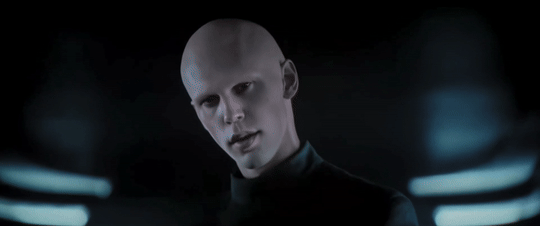
Sure, he’s the most violent and unhinged madman this side of Gamma Waiping, but even Feyd knows there’s a time and place for everything.
The time being when the Atreides are defeated and the Emperor rewards him and he’s free to go after the Fenrings with his Harkonnen troops.
First, they find Count Hasimir, a frail little man with rodent-like features and thin greying hair. The Emperor’s oldest friend, and the best assassin in the known universe. Feyd knows better than to take him on in single combat, so he has his men deal with him while he goes after Margot.
He finds her in the furthest room of their castle past a cadre of guards that he makes short work of. She’s holding a little girl’s hand… Small and pale with thick dark ringlets, she looks just like he did as a child. He can tell even past the thick visor of the helm he wears — something made to not only protect but also block out sound. Margot knows it’s him just by his gait. She speaks, but it doesn’t matter. Her voice has no effect this time.
He sees the flash of a laser on the wall as his men join him and block the only exit. Feyd walks over to Margot, uncoils the little girl’s hand from hers, and takes her away. Lady Fenring will be brought to Kaitain to answer for her crimes against the once-young na-Baron. The Bene Gesserits, humbled after their near defeat on Arrakis, will not defend her actions — she has already served her purpose anyway.
The little girl looks up at him as they walk away with an unsettling and knowing light in her dark eyes. Feyd gazes down at her and, although she could not see his face, it was as if they’d always known each other.
But he also notices her little legs can hardly keep up with his stride. Oh, that’s right, children are smaller… He stops, kneels, and lifts her up into his arms as he carries her back to the ship.
He was actually nervous about taking off his helmet in front of her. What would she think of seeing a Harkonnen for the first time? They were so different from the soft and sunkissed people of the planet she was raised on…
But she had an eery calm to her even at the age of seven standard years. She regards him no differently than before and also does not acknowledge any need for reverence, even when he tells her who he is.
“Feyd-Rautha Harkonnen.” “Hello.” “And what’s your name?” “Marie.”
He found himself genuinely shy when he informed her he was her father, and was all the more surprised to find an impish smile grow on her face. “I know.” Margot must have told her after all…
She doesn’t cry, she doesn’t seem afraid, but Feyd comforts her the whole way to their home planet. He pets her dark crown of curls as she sits beside him on the ship, supports her back when she drinks, and makes out of galactic maps the most unusual of toys to distract her with on the long journey back. None of it comes naturally to him and for the first time he has to think before he acts. It leaves his nerves rattled, but every time she looks up into his eyes and smiles so innocently he gains his calm again.
Giedi Prime was not the first place he had in mind for raising a child, but the other planets he could lay claim to — Lankiveil and Arrakis — were not great choices either. Now that he was Baron, this was where he had to be — at least until the Emperor decided who should govern Arrakis following the trouble with the Fremen. The Corrinos left a cadre of Mentats in charge to oversee the change for now.
She hates the planet at first, scrunching up her little face at the stark white light during the day, at the poisonous smoke, at the vast black wastes filled with petrol. Feyd engages an ecologist the first week Marie is there and plans a series of greenhouses for her with the best water filtration systems spice can buy.
“Why can’t the whole planet be like this?” she asks when he first shows it to her. They walk through young trees, Feyd dodging thin branches of raw red and green while his daughter skips ahead like a lamb. “Because it just can’t,” he mutters. “But why?” “Because it would cost too much.” “How much?” “I don’t know.” “Why not?”
A secret communication arrives to the Emperor inquiring whether he has room in his court for a new assassin now that Hasimir Fenring is gone.
His days are split between official duties, training in the arena, and playing with Marie. He discovers a part of himself again when he is with her — that innocent part that had been lost or buried when he first got to Giedi Prime. There is a satisfaction in making it for her a less brutal arrival, even a pleasant one.
He finds her laughing as she runs through the long halls, tugging on the lances of the guards — who look horrified at the sight of a playful child for the first time, but stay obediently still — and throwing rocks into the oil pools outside the palace to gawk at the pretty rainbow colours.
She loves the vaporous transparent gowns the servants wear, and the servants love her too. They dote on her, fearfully at first but more boldly when they notice Feyd’s approval. The retention rate goes up starkly at the palace, as does the average longevity.
Everyone is puzzled about what to do with her hair, but Marie teaches Feyd to braid it the way her mother did. She’s not shy about berating him either whenever he gets it wrong.
And most nights he falls asleep with her in one arm and a holographic storyreel in the other. He wants to be the sort of parent he only briefly had, the kind he vaguely remembers from his years on Lankiveil.
He dreams of his mother now more than he ever did, and wakes up feeling sorry for how much he falls short. He has no idea how to care for a child, no idea of how to raise her, but he knows he wants to try. Wants to succeed, for her. Marie might not have been an intended child, the way he was, but she was his own flesh and blood and he’d be damned before he made her feel unwanted.
His harpies love her, of course. But he fears they do a bit too much and dismisses them not one month after Marie arrives on the planet. While he’s never indulged, he can only imagine with a frightful shiver how sweet and tender a child’s flesh is.
To the consternation of his people, he flies in tutors from other planets for her. Philosophers from Ecaz, musicians from Chusuk, biologists from Lernaeus, and even a historian from Kaitain itself. She has a Mentat but no Bene Gesserit to serve in her education. His uncle had been wrong about a lot of things, but the scheming of witches was not one of them.
Her bedroom — more white and pale blue than the standard inky black, and decorated with pink ribbons — has a court of dollies on one side and toy swords on the other. Feyd’s love of weaponry does not escape her and, in her childish innocence, she’s fascinated by it all. He takes delight in this, of course, but worries too. Imagining his little child with blood on her hands scares him, and it makes him wonder what sort of person his uncle was to encourage it in him.
In loving her, Feyd’s never felt more unloved himself. Sure, he had his mother and father at one point, but all of that was taken from him when he was Marie’s age. Since then, nobody had cared about him, nobody had even wanted him unless it was to fulfil a purpose. Not his uncle, not his brother, not even Margot…
He comforted himself now that he’d spared Marie of such a fate. His little girl would not become a glorified breeding horse for the Bene Gesserits nor a pawn in the Emperor’s games. He would fill her life with all the things he never had.
Marie grows as the gardens grow, and Feyd begins to speak with the professor from Lernaeus and a retired planetologist from Acline about plans for terraforming Giedi Prime, and one day putting Marie in charge. Her lessons become more structured.
A fact to which she protests, but not for long. She is clever for her age, and understanding, and nobody can explain to her better than Feyd that, although learning can seem useless and boring compared to play, she needs to prepare for the years to come.
“You like the gardens, don’t you?” “Yes…” “And you like eating fruit, right?” “Yes, and smelling flowers.” “What if you could do that all the time, then? Not just in the greenhouses?”
She comes to like the skies of Giedi Prime as well, and the way fireworks look like ink blots. Her every birthday is marked with an array of black and white that make the sky a work of art.
Marie never asks to be the sort of Baroness that always lays around, because Feyd doesn’t do that either. As she grows older he starts to spend more time with her during the day, letting her sit in on meetings, and they debate for hours afterwards on what course the Barony should take. He finds she is more brave than he is, but more reckless too.
“No, little melon, we can’t just declare war on them.” “But why? You know they’re spying on us…” “Yes, but we have no proof.” “Of course we have proof. How would you know otherwise?” “Proof needs to be physical or recorded.” “Let’s record them spying, then.” “Well now they know that we know, so they will have a different approach.” “I still think war would end the problem faster. Or challenge them to a duel!” “I’m getting too old for this…”
They see more of the planet together too, venturing to the caves and crevices that run beneath the surface, taking samples of the native life bubbling in hot springs and collecting crystalline samples.
He takes her to Lankiveil for her fifteenth birthday and they sail together through its icy floes. She loves the sign of whales off in the distance and sounding the ship’s horn, although the local food leaves much to be desired.
“It smells weird.” “It’s fish.” “They stink…” “You want a salad instead?” “Yes, please…”
By the time she turns eighteen, the Emperor has decided to put Arrakis back into Harkonnen hands, and Feyd is terrified. As bad as Giedi Prime is, he wants to see her on Dune even less. Marie can tell this, observant as she is. She’s grown more quiet when she’s thinking and less rash with her decisions, but loud when she wants to be, and daring.
Feyd doesn’t know what to expect of Arrakis anymore and has mixed feelings about it, but he knows one thing for certain: anyone who’s a threat to his daughter there, dies.
“I’ll miss Giedi Prime,” she says as they’re approaching orbit. “It’s finally getting green in places, and rainclouds have begun to form…” “You can go back any time, you know,” says Feyd immediately. “I won’t keep you on this piece of hell…” “I’ll stay,” says Marie. She has the same strange determination she had in her eyes the day they met. “I heard it has old terraforming stations… I’ll want to visit them one day.”
It isn’t easy ruling a desert planet, even one that’s been subdued, but the new spice flow makes it worth it. Feyd keeps Marie close, teaches her everything, watches her grow, and soon she’s sent in delegations reporting to the Landsraad. She represents House Harkonnen better than her great uncle did — and, to Feyd’s pride, better than he ever could.
#Feyd-Rautha Harkonnen#Marie Fenring#Feyd-Rautha#Feyd-Rautha imagine#Feyd-Rautha headcanons#Dune part 2#Dune imagine#Dune headcanons#Feyd#Dune#feyd rautha#feyd rautha harkonnen#feyd rautha imagine#feyd rautha headcanons#sswallow;headcanons#sswallow;made a thing
217 notes
·
View notes
Text
Unexpected Reunion

Characters: Astarion x Gale Summary: Five hundred years after the events of BG3, the world of Faerûn has moved on and entered into a modern era. An art gallery at a prominent museum has opened up to display works from the 1400s, drawing the attention of two beloved characters, who did not expect to meet again so soon. A/N: February is the month of birthdays for so many friends! This was written as a gift for the super talented @unforgiving-girl for her birthdayyy. I heard she liked bloodweave and art by many classical and beloved painters so I wanted a homage to both. Enjoy!
NEW EXHIBITION! The Age of Heroes, Gods, and Monsters Baldurian Art from 1300-1500
The glossy sign stood just outside of the museum gallery, beckoning guests and visitors to come see the collection of artworks that had recently been rediscovered and carefully curated into this new display. The word online was that museum curators had just successfully acquired a whole set of Fevras portraits and other art of the 1490s, a collection that had been packed away in someone’s attic for two or three hundred years after they had disappeared from the noble halls and castles during one strife or another. Now they were unveiling a new wing to put all the art of the fourteenth and fifteenth centuries in one place.
Immerse yourself in rich Baldurian history! the marketing materials online said. See how art and culture were transformed during some of the most tumultuous times of Baldur’s Gate’s history. Witness the sharp upheaval of the infamous Times of Troubles. Gaze at portraits of heroes and tyrants alike, from Sarevok to Lord Gortash, from Duke Eltan to young Wyll Ravengard. Ruminate over paintings and sculptures of gods both beloved and forgotten. Expansive and dynamic, this exhibition places famous works alongside newly discovered treasures to tell the story of wars, conflicts, and adventures that shook the realms, all centered around our very own Baldur’s Gate.
Just outside of the hall, a white-haired young man paused, a black umbrella hooked over one arm, contemplating first the exhibition sign and then the steady stream of visitors making their way into the gallery. The exhibition had attracted folk of all kinds. Elderly couples walked slowly from work to work, taking their time to gaze and study. A group of uniformed schoolchildren followed along behind their teacher, notebooks in their hands, listening to her explain the rules of the museum. Further down the hall, tourists paused beside the more famous artworks, glancing down at their printed guides and museum maps before moving on to the next most well-known work.
To all of them, these paintings and sculptures were all a part of some distant, mythical history. Even the oldest elf in the room seemed too young to have a living memory of these events, enough to tell what was real history from dynamic reimagining. Not so for the white-haired guest. Where others saw the distant, impersonal past, he saw intimate memory.
He took a deep breath to steady himself—a habit not even centuries of vampirism had entirely cured—and entered the gallery. At first, it was only a little uncanny. The old paintings and marble busts from the 1300s that he had seen hanging in different manors and noble estates now featured together at the start of this gallery. The farther he walked, the further in time he traveled, moving out of a century he could only barely remember as a hazy blur into a time that was burned into his memory with sharp clarity.
The 1490s was a decade of great change for Baldur’s Gate, a large placard read between sections in the gallery. Between the technological innovations of organizations like the Gondian and Ironhand Gnomes, dangerous industrial updates to the city’s infrastructure and law enforcement, and the infamous Dead Three attempting to control an Elderbrain, resulting in widespread destruction, this decade gave rise to a full spectrum of art, from loving homages to the simplicity of home to the veneration of heroes, and from the tumult of war to the celebration of innovative design.
Ha, the visitor thought, smirking at the placard. It shouldn’t be so easy to summarize the events of history in just a few sentences.
He paced even more slowly in front of the paintings now. Some were no bigger than a piece of printer paper, some large enough to span floor-to-ceiling on the cream-colored walls. Vistas of magical battles, nautiloids in a swirling cloudy sky over a city burning with red and purple flame, sat next to careful still-life studies of fruit, flowers, or skulls. An imposing portrait of Duke Ulder Ravengard sat opposite an equally imposing portrait of Lord Gortash. Not far off, an all-too-familiar painting of a white-skinned woman curled sensually around the body of a red-skinned tiefling stretched seven feet tall, still in its original skull-topped frame. He was surprised that one made the cut, but then he recognized a few dark paintings from Cazador’s manor, too. And one that he swore he’d only ever seen in Raphael’s House of Hope.
He was nearing the end of the gallery now when his eyes finally landed on the one painting he had come here to see. When he first heard the news about the rediscovery of a few Fevras portraits, he wasn’t certain this one was among them. It wasn’t until someone texted him a photo of the gallery uploaded online, a quick red circle added clumsily around a painting on one wall, that he knew.
He paused in front of the portrait, a strange mix of emotions swirling within him. Nostalgia, humor, regret, and longing. This…was him. Him as he was five hundred years ago. Him as he was in that present moment, physically unchanged by the ravages of time but altered nonetheless.
To every other visitor to the museum, the portrait featured an aloof, mysterious young elven man, his skin as pale as moonbeams, his silver hair styled in perfect curls swept up and out of his face. His crimson eyes glimmered like rubies, standing out stark red in his otherwise white face, framed with dark lashes that cast the subtlest of shadows over his eyes. He lounged in a plush red chair—it seemed so gaudy now looking back—clothed in a well-tailored outfit of black, silver, and red. The height of fashion at the time. As he lounged, he leaned his cheek lightly against the fingers of one hand, a confident, easy smirk on his lips. The figure bore the essence of catlike, predatory grace, beckoning you closer with his eyes while waiting to pounce on you once you got too close.
He glanced at the art placard next to it.
Oskar Fevras 1452-1517, Baldur’s Gate, Faerûn Portrait of a (Comparatively) Young Vampire 1492 Oil on canvas
Not even a little description or bit of history. Not even his name. Just a reference to that fop of an artist and a title that must have been added recently. He folded his arms, frowning. It wasn’t as though the name Astarion Ancunin was unknown, even all these centuries later…
Still…he had to admit, it was good to see that face again.
“Well, well! What a surprise to see this here. We went through a lot of trouble to earn that portrait, as I recall.”
Astarion turned, the familiar voice snapping him out of his thoughts. An older gentleman stepped out of the crowd, well-dressed in a thin dark purple sweater and a blazer, a pair of gold-framed glasses perched on his nose. His thick hair and well-trimmed beard were snowy white and his face bore a few more wrinkles around the eyes and mouth than the last time Astarion had seen him, but the modern style overall made him look no older than fifty. Age had not dulled his brown eyes one bit—they sparkled with good-natured humor just as much now as they had done that first year they’d traveled together.
Astarion smirked. “My, my. If it isn’t Gale Dekarios.”
Gale smiled in return, the corners of his eyes crinkling. “Astarion. You’re looking as devilishly handsome as ever.” His eyes flicked to the portrait and then again to Astarion, amusement glimmering in his eyes.
“And you don’t look a day over three hundred, darling. In fact, you look better at six hundred than you did at sixty, though I’m sure Elminster is deeply disappointed in the state of that beard.”
“Five hundred, I’ll remind you, but I’ll take the compliment in the spirit in which it was given.” Gale chuckled, stroking his carefully trimmed beard. “And while Elminster would say any decent wizard is only as good as his beard, we must keep up with the times. Trim and clean is the order of the day.”
“I’m certain Blackstaff University doesn’t mind if its Professor Emeritus has a beard down to his knees. I’m told it’s a time-honored tradition among their venerated wizard staff.”
“Perhaps they wouldn’t mind, but I would. I’ve never been one for tradition.” Gale shrugged and then shook his head. “Gods, how long has it been?”
Astarion tilted his head, one curl slipping free of his combed hairstyle and falling onto his temple. “Since when? Since we found ourselves trapped in an artist’s haunted manor fighting poltergeists?” He knew what Gale was actually asking, but he didn’t want to answer just yet. He didn’t want to acknowledge the distance or the time.
“Since we last met. Ages, surely. Well, not literally but…figuratively.”
Every day apart feels like an age to you, Astarion thought idly, but those were the echoes of lovesick words Gale used to whisper in his ears more than three centuries ago. This was a different time. A new era.
It didn’t stop the memories from flooding back, however. He recalled easily those stumbling first steps of their unexpected romance, back when they were both the hapless adventurers caught up in a grand scheme that pitted gods and mortals and illithids against one another. The way Gale had conjured whole worlds out of magic for him. The way Astarion had learned, one hesitant step at a time, to trust and even, eventually, slowly, to love. The way they had lain together at night and discussed the future, their words trailing off in the darkness, and how Gale had assuaged Astarion’s rising panic that he would one day face a world without him with the promise of finding ways to extend his life.
If Elminster can live this long as a Chosen of Mystra, perhaps I can find a way, too. The perks of being a god’s Chosen are not so easily lost, Astarion, even if Mystra and I are on the outs.
He had found a way, an effective kind of immortality that required no vampirism, no lichdom, and no chains binding himself to Mystra. And for a century, everything had been perfect.
But time wore down so many things, including love. A second century and a third were spent with the two of them like passing ships that occasionally docked in the same harbors. A visit here and there, a night of passion to rekindle old flames, only to let them softly smolder into dying embers by the next morning. Gale had plenty to keep him busy. Astarion wanted to see the world as it was evolving and changing around him. They began to meet less and less often, their interactions reduced to affectionate but politely distant letters.
They never could forget one another, though. With the advent of every new form of communication, they seemed to find each other again. Astarion still had Gale’s first telegram to him sitting in a box among letters on parchment, paper, and postcards spanning a handful of centuries. He remembered the first time he heard Gale’s voice, tinny and staticky, in the first telephone call they had shared, and the first email Gale had sent him, and the first text message. Gale always knew how to find him, somehow. Even when Astarion put distance between them all over again, it was only inevitable that Gale would come into his orbit again eventually. Like a particularly chatty comet.
“I’d say it’s been a few decades or so,” Astarion answered at last. “Everything keeps us so busy these days. But what brings you here?”
“I heard they uncovered a set of Fevras portraits,” Gale said. “I came to see if yours made it into the gallery. It is, in my unbiased opinion, the best portrait that cad ever painted. I’m gratified to see this museum continues to have discerning tastes.”
“Maybe now it’s finally worth the cost we paid to get the damned thing.”
Gale waved his hand, an expensive silver watch glinting faintly in the museum lights. “Oh, it was worth it the day we got it.”
Astarion said nothing to that, merely smiling. How could he forget the day they’d gotten the painting? Oskar had sent a messenger to their room at the Elfsong, saying the portrait was done at last, and Gale had insisted Astarion wait in the room while he fetched it himself. It had been a whole event, with Gale asking him to cover his eyes while he brought the painting inside, threatening to cast darkness over him if he didn’t comply. He had held Astarion’s hand the moment that he opened his eyes to behold the painting, and squeezed his fingers reassuringly when they began to tremble from the wave of emotion that threatened to overwhelm him.
After nearly two hundred years since he became a vampire…he could see his own face again.
It’s an uncannily realistic likeness, Gale had said softly. As handsome on canvas as what I see before me now.
“I never should have given it up,” Astarion murmured to himself. It had been a rash decision made at the height of one of their lovers' spats far too long ago. He’d wanted nothing to do with any of Gale’s gifts at the time, so off the portrait went, packed in a crate and sold to some fanatic who really loved Oskar Fevras’s works. And then it had disappeared. Until now.
Gale didn’t seem to hear him, or was very politely feigning ignorance. He looked around the gallery with interest and said, “You know, it’s a shame your statue got destroyed a while back. It would have been a fine addition to these hallowed halls.”
“It was supposed to be a fine addition to my gardens,” Astarion quipped. “And it was, right until someone’s magical experiments turned the whole place into a small crater.”
Gale winced but tried to offer an apologetic smile. “A mistake for which I still have yet to atone, it seems. I did offer to replace it. At least a dozen times.”
“It wouldn’t have been the same. That one had been a gift.” From you, like everything else I owned at the time. Like everything else I held precious until I couldn’t stand to look at it anymore.
He left those words unsaid.
“I know.” Gale gave a small sigh, his good humor faltering a little. “We never realize what is truly irreplaceable until it is already gone from us.”
Astarion said nothing. He never knew what to say in the face of Gale’s philosophizing. Especially when each thought seemed to hint at his ongoing, never-ending, eternal affection for him. How does one carry that kind of love for so long?
But the fact was, Gale didn’t carry that kind of love, not eternally. What had kindled in 1492 was not what they had sustained, broken, reforged, and let dim over the next few hundred years. For five centuries they had lived in the same world, usually on the same continent, often within the same city. For five centuries, Astarion had found himself sharing in a love with Gale that had morphed and changed, burning bright with the flash and bang of a firework, simmering slow and steady like the flame on a stove, flickering distantly in the dark like a candle flame on a pitch black night. As their lives adapted, so did their love. Even when all appeared to be over, for good, forever, as it did when they last parted amicably several decades ago, Gale’s affection for him was like the last stubborn ember in a long-forgotten fire. One soft breath could revive it back to life.
Perhaps, if Astarion gave it more than a moment’s thought, it was the same for him. It was good to see Gale again. There was none of the ache and shame right now that he had carried in previous encounters. Maybe that would come later but for now…
With love like a tiny ember nestled at the bottom of a cold stone hearth, Astarion let Gale’s presence come in like an early spring breeze, blowing color back into the coals, first red, then orange, then white. No flame yet, but the potential as there.
“It’s good to see you again,” Astarion said at last, his voice soft.
Gale’s smile was as warm and free of judgment or condemnation as ever. “And you, Astarion. I’m always glad to see you.”
“And who wouldn’t be?” Astarion said, fixing the wayward curl in his gelled hair. “Honestly.”
Gale chuckled. He had long grown used to Astarion’s dismissive nature. “Are you free the rest of today? We should get coffee and catch up. There’s a cafe not far from here that caters to vampires.”
Astarion examined his nails as if the prospect didn’t secretly add more breath to the embers within him, encouraging a flurry of briefly flickering sparks. “I could free up some time in my busy, busy schedule, I suppose.”
“I shall endeavor not to take up too much of your precious time, then,” Gale said, tone dry. But then, glancing at the portrait again, he seemed to get an idea. He pulled his phone out of his blazer pocket. “Before we go—we should take a photo by the painting. What do they call it these days? A selfie.”
Astarion raised his eyebrows. “What would be the point? You know as well as I do, darling, vampires don’t show up in photos any more than they show up in mirrors.”
“Indulge me.” Gale opened the camera, after a few hesitant swipes that suggested he was still getting used to this model of smartphone, and waved over a young half-elven woman who was passing by with a few of her friends. “Do you mind taking a photo of us in front of this painting? No flash of course. I think I’ve already turned it off.”
She nodded. “Sure.”
As she took the phone and held it up for them, Gale smiled at Astarion and gestured for him to join him by the painting. Astarion sighed softly, adjusting his hold on his umbrella, but went to stand next to him, trying to ignore that little voice that tried to convince him this was silly, embarrassing, and a waste of time.
“This isn’t a selfie, Gale,” Astarion said.
Gale waved this remark away. “Pish posh. It’s a photo with our selves in it. Same thing”
“Ready?” the girl asked, watching them.
Gale put a hand on Astarion’s back, smiling at him when Astarion glanced over uncertainly. But the touch was familiar, safely near Astarion’s shoulder blades, and despite his desire to get this photo business over with as quickly as possible, Astarion felt himself relax as he fit himself against Gale’s side. He looped an arm around Gale’s waist, resting his hand on his hip as he’d done countless times before.
“You owe me for this,” he whispered, giving Gale’s hip a small squeeze. Gale’s smile broadened and he shifted his hold, his arm now fully around Astarion so he could give a returning squeeze to his shoulder.
“Coffee first,” he murmured back. “We can see where we go from there.”
The girl cleared her throat, looking uncertainly between them. “Umm…”
“Sorry, we’re ready now,” Gale said. He gave Astarion’s shoulder another squeeze. “Smile!”
Astarion rolled his eyes but summoned his usual close-lipped smirk. The girl looked back down at the phone in her hands, shifting to center them and the portrait in the frame. Then her hands faltered, her expression shifting. She glanced between the screen and them a few times, and then blinked hard and looked again.
“Is there a problem?” Gale called pleasantly. The girl jolted.
“N-no! Of course not. One sec.” She tapped the screen a few times and then turned the phone sideways and caught a few photos that way too. Behind her, her friends started to whisper to one another and point. The girl lowered the phone with a forced cheerful smile. “Done!”
“Thank you so much,” Gale said, reaching for his phone back. As soon as it was out of her hands, the girl scurried back to her friends, whispering quickly as they hurried down the gallery. Astarion couldn’t help but catch a few phrases as they passed by.
Did you see that? I’m not crazy, right, that guy is—
—really him? In the painting? It has to be the same guy—
—just a coincidence, right, like, vampires don’t live that long—
—but he didn’t even show up in the camera!
“You’ll have me in the tabloids tomorrow,” Astarion said. “I’ll go viral on TikTok soon if we don’t leave now.”
“I’m not even sure I know what that is,” Gale said amiably, opening his photos. He paused, smiling fondly down at one of the photos and then turned the phone so Astarion could see. “What do you think? We finally got your face on camera.”
Astarion hesitated but peered at the screen, curious. For a split second, he half expected his portrait to be faceless, but every detail remained, down to the supple curve of his lips and the sharp red color of his eyes. Just off to the side of the portrait, a white-haired Gale stood with his arm around a headless body dressed in expensive, tailored clothing. Astarion had put one hand in his pocket, his umbrella hanging from his wrist, but his other should have appeared at Gale’s side. Instead, there was nothing to see there except for an odd wrinkling in Gale’s blazer, enough to suggest a phantom touch. The space above Astarion’s high-collar shirt showed nothing but the wall behind him and a hazy, thin shadow to suggest the shape of a head.
“You still can’t see my actual face,” Astarion said, straightening. “You could have simply taken a picture with the portrait yourself.”
“But then you wouldn’t have been in it.” A mischievous glint then entered Gale’s brown eyes. “I can have someone edit your portrait face over your body if that helps.”
He scrunched his nose with distaste. “No thank you, let’s not make this photo any worse than it already is.”
But Gale’s initial words continued to warm the coals within Astarion’s chest. You wouldn’t have been in it. Now he was, a body that was leaning comfortably into Gale’s side, with an arm wrapped around him and an invisible hand resting naturally on Gale’s hip.
“Send me that,” Astarion said after a second, and then promptly turned on his heel and walked away.
“Of course, I—wait a moment! Where are you going?”
Astarion paused and glanced over his shoulder. “We’re attracting attention. And you promised me coffee, didn’t you? So let’s go.”
The smile on Gale’s face was the same as it had been five hundred years ago, before there were camera phones and cars, before pictures or postcards or planes. The same smile Astarion had felt it was impossible to say no to in almost every era. Gale jogged to catch up with him, that smile never faltering, and stayed step by step with him as they made their way to the entrance of the museum. Together, the two of them stepped out into the sun, sheltered in the shade of Astarion’s black umbrella, reunited once again in a new age, a new era.
#happy birthdayyyy#everyone can have random bloodweave as a treat#its kind of a modern day AU but like#not modern earth so#idk#bg3#baldur's gate 3#astarion#astarion ancunin#gale dekarios#gale of waterdeep#bloodweave#gale x astarion#my fic#bg3 fic#i don't even go here (the bloodweave fandom) so hopefully i did the boys justice <3
55 notes
·
View notes
Text
Chekhov Reads Dungeon Meshi: CH47
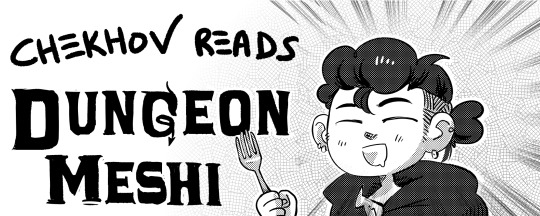
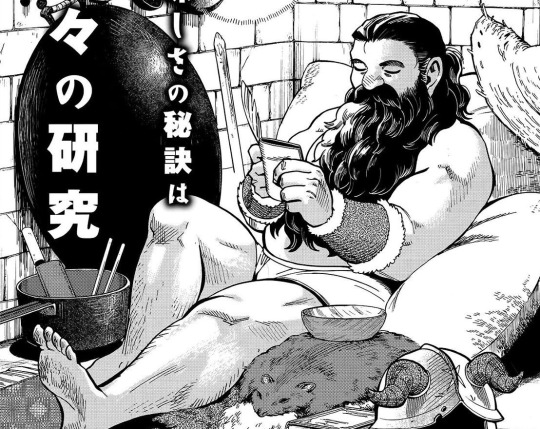
I would like to thank Ryoko Kui for this.
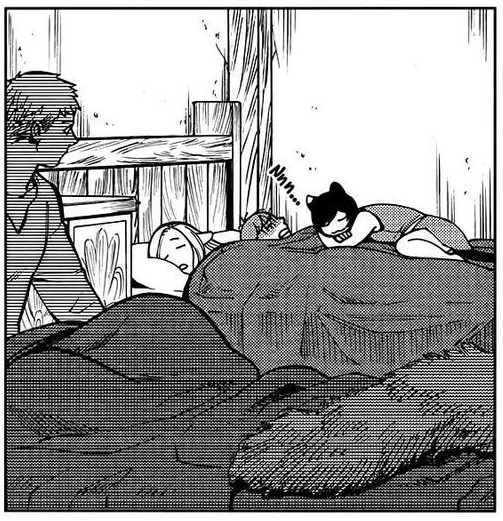
I really love how, despite being antagonistic with Chilchuck, Izutsumi seems to like Marcille and him the best out of all the rest.

You know they're Japanese pancakes with that amount of air padding them out.... 😂
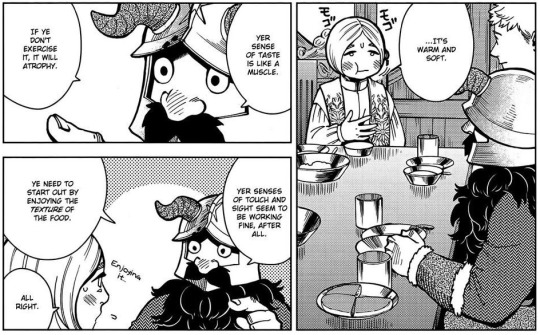
You know, it's interesting because if I remember correctly, taste is the oldest sense we have. Basic organisms surviving in water needed to be able to taste the environment in order to allow it to move away from acidic water, or dangerous environments. So it's curious that their taste is no longer working while their other senses remain.
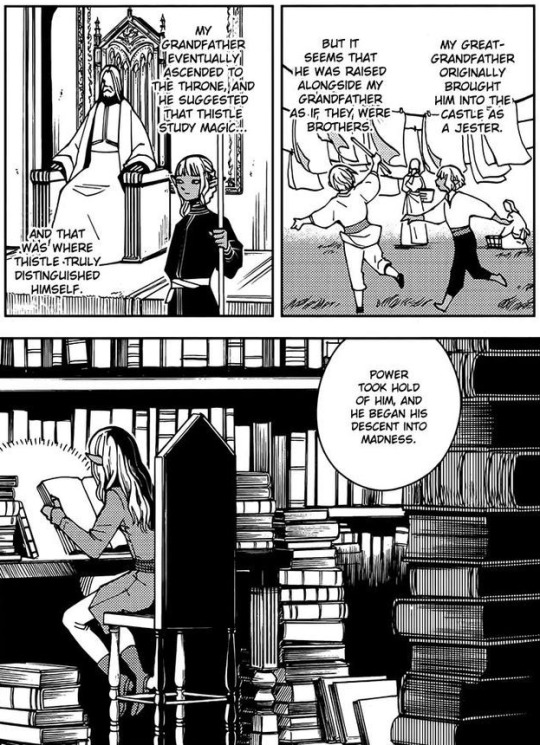
....sounds like it was maybe less of the...power.... and maybe more of the fact that his old childhood friend was growing old?
....... y'know. Just suggesting...
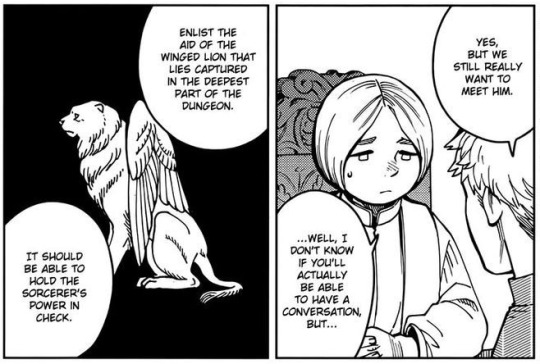
To fight a trainer with a powerful pokemon, you must first capture a powerful pokemon yourself.
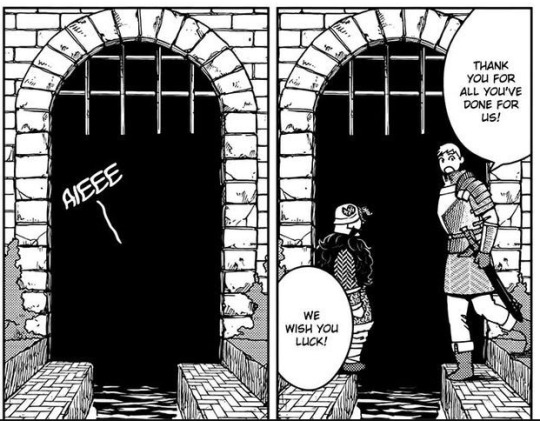
AIEEEEE~

I was JUST about to say "man, this kid seems to be a genuinely good leader! His people don't fear him and he has a good head on his shoulders. I sure hope nothing bad happens to him!"
And here we are.

Oooooh a forest? Or one of those water places.
Update: One of those water places. A cistern.
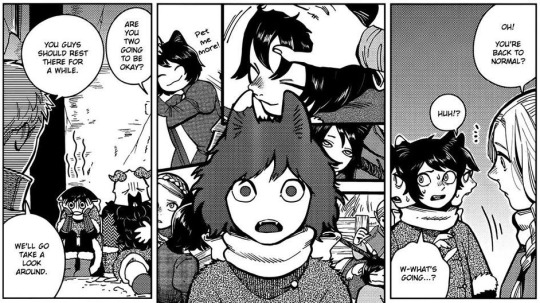
Her charm wore off! And now she can experience unspeakable horrors of being known in a vulnerable state.

Someone get this poor man some google maps.

Laios, why do you look.... less than thrilled with this information?
Oh, his Fixation Sense is tingling, that's why.
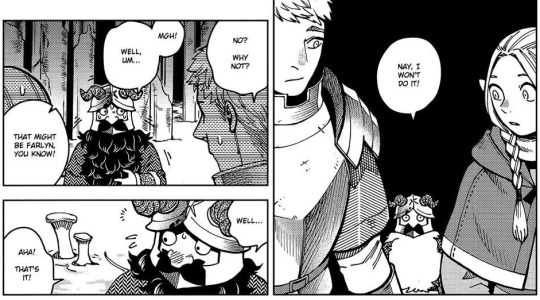
Oh? Rare Senshi moment of stubbornness?
Mayhaps even.... A BACKSTORY?
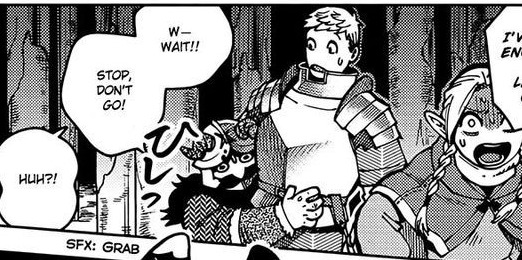
When the party is in Analysis Paralysis and the DM says 'roll initiative'
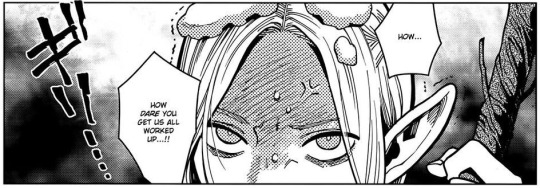
Marcille is taking this Crazy Future Girlfriend thing to all new highs.
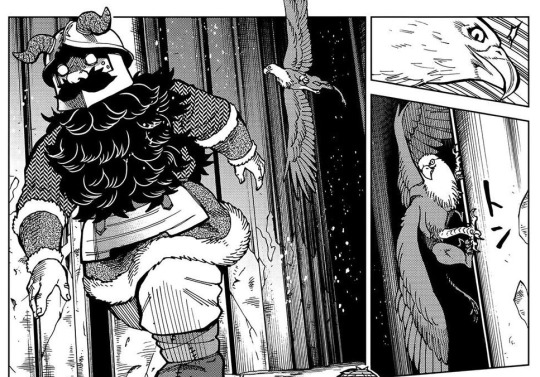
Is he afraid of birds? Or lions? Or both? What is happening here? It makes no sense. It would be delicious! Senshi, stop that's like 60 kg of chicken wings, easy!
BONUS:

Here's the thing. They aren't like, twins necessarily. But I do think that Falin, while she's just as weird as Laios is, makes herself approachable to people. She cares about ghosts as beings, instead of seeing them only as a scientific anomaly.
But other than that.... honestly I feel like Toshi wouldn't fall in love with a female Laios either.
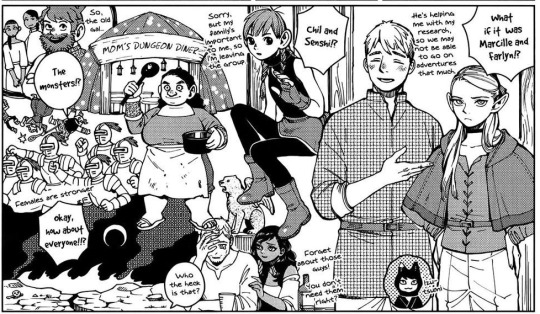
Marcille and Falin being MORE likely to go out to the dungeon as women makes sense somehow. Though I am amused at how femme-leaning all elves are naturally.
I think these gender twists are all pretty surface level but given that it's a conversation the party has in real time... I get it.
363 notes
·
View notes
Text
Navigation chart
These are charts that are primarily designed and used for navigation. The chart contains most of the information a navigator needs, including latitude and longitude, topographical features, navigational aids such as lighthouses and indications of reefs and shallows, water depth and warnings. This information makes it possible both to chart a safe course and to check progress during the voyage.

Portolan chart by Jorge de Aguiar (1492), the oldest known signed and dated chart of Portuguese origin (Beinecke Rare Book and Manuscript Library, Yale University, New Haven, USA)
The first nautical charts were produced at the end of the 13th century. The appearance of the magnetic compass 100 years earlier is regarded as the catalyst for the development of nautical charts. Prior to this, sailors had relied on the proximity of a known coastline, the position of celestial bodies or meteorological phenomena such as the monsoon winds in the Indian Ocean. The less predictable winds and weather conditions in the Mediterranean provided the impetus for the development of the first nautical charts. These were plane maps (without taking into account the curvature of the earth), which were regularly crossed by rhumb lines that corresponded to the probable wind direction.
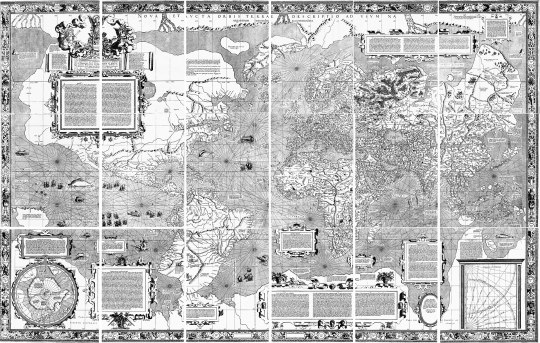
Mercator 1569 world map composite of all 18 sheets, by Gerardus Mercator (1512–1594)
The plane maps were unsuitable for navigation in the northern and southern latitudes and were replaced in the 17th century by maps in Mercator projection, which depicted the compass directions as straight lines. Projections other than the Mercator projection are also used, especially at very high latitudes.
101 notes
·
View notes
Text
Morning's Canvas
Rosy fingered dawn crept in like a whisper, soft and unhurried, painting the room in hues of gold and gray. Sirius lay awake, his restless fingers tracing patterns on the rumpled sheets, his mind alive with the kind of energy that only the early hours could bring. Beside him, Remus slept, his breath steady and deep, his face serene in the way that only sleep could make it. The contrast between them was a quiet symphony—Sirius, the spark of lightning; Remus, the calm of the earth.
Sirius propped himself up on one elbow, his gaze lingering on Remus. The morning light filtered through the curtains, casting delicate shadows across Remus's skin. His freckles, faint and scattered like constellations, seemed to call to Sirius, begging to be mapped, to be known. Sirius smiled, a small, private thing, and reached out, his fingertips hovering just above Remus's shoulder.
He began with the lightest touch, a featherstroke along the curve of Remus's collarbone. Remus stirred, a faint hum escaping his lips, but he didn’t wake. Sirius’s smile deepened, and he continued, his fingers dancing in slow, deliberate movements. He traced the lines of Remus’s shoulders, the dip of his spine, the rise and fall of his ribs. Each touch was a word, a note, a brushstroke on the canvas of Remus’s skin.
Sirius’s mind wandered as he worked, his thoughts as fluid as the morning light. He thought of the way Remus laughed, low and warm, like the rumble of distant thunder. He thought of the way Remus’s hands, calloused and steady, could hold the weight of the world and still feel gentle against Sirius’s cheek. He thought of the way Remus’s eyes, golden and knowing, could see straight through him, past the bravado and the chaos, to the heart of him.
His fingers moved to Remus’s arm, tracing the scars that marred his skin. Each one was a story, a battle fought and survived. Sirius’s touch lingered there, reverent and tender, as if he could heal the wounds with his love alone. He leaned down, pressing a kiss to the oldest scar, the one that ran from elbow to wrist. Remus sighed in his sleep, a soft, contented sound that made Sirius’s chest ache with something too vast to name.
“You’re my masterpiece,” Sirius murmured, his voice barely audible, as if speaking too loudly might shatter the moment. “Every line, every scar, every freckle. You’re perfect.”
Remus’s eyes fluttered open then, slow and heavy with sleep. He blinked up at Sirius, a lazy smile spreading across his face. “Morning,” he said, his voice rough and warm.
“Morning,” Sirius replied, his fingers still tracing idle patterns on Remus’s skin. “Did I wake you?”
“Mmm. Felt like you were drawing on me again.” Remus’s smile turned teasing. “What is it this time? Another map of the stars?”
Sirius grinned, unrepentant. “Maybe. Or maybe it’s just you. You’re my favorite thing to draw, you know.”
Remus chuckled, the sound low and rich. “Flatterer.” He reached up, his hand brushing against Sirius’s cheek. “You’re ridiculous.”
“And yet you love me,” Sirius said, leaning into the touch.
“Yes I do,” Remus agreed, his thumb brushing over Sirius’s bottom lip. “Even when you wake me up at the crack of dawn with your artistic endeavors.”
Sirius laughed, the sound bright and unrestrained. He leaned down, capturing Remus’s lips in a kiss that was slow and sweet, a promise and a prayer all at once. When he pulled away, Remus’s eyes were soft, his smile tender.
“Go back to sleep,” Sirius whispered, brushing a strand of hair from Remus’s forehead. “I’ll be here when you wake up.”
Remus’s eyes drifted shut, his breathing evening out almost immediately. Sirius watched him for a moment longer, his heart full to bursting. Then he lay back down, his hand resting lightly on Remus’s chest, feeling the steady beat of his heart.
The morning stretched on, lazy and golden, and Sirius let himself drift, his thoughts as light as the sunlight streaming through the window. In the quiet, in the stillness, he found a kind of peace he had never known before. And as Remus slept beside him, his skin still warm under Sirius’s touch, Sirius knew that this—this was his masterpiece. Not drawn in lines or strokes, but in moments, in love, in the quiet beauty of a shared life.
And it was perfect.
#wolfstar#remus x sirius#sirius loves remus#remus loves sirius#sirius black#sirius#remus#remus lupin#wolfstar fanfiction#wolfstar fic#the marauders#marauders fandom#marauders fic#my writing#my fic
38 notes
·
View notes
Photo

A Roman Trail in the Moselle Valley
The Moselle Valley is Germany's oldest winegrowing region. The Romans brought viticulture to this area and planted vines along the Moselle River 2000 years ago. After settling the region c. 50 BCE and establishing the city of Trier (Augusta Treverorum) in 17 BCE, a Gallo-Roman culture developed in the territory of the Belgic Treveri tribe that inhabited the valley in what is now Luxembourg, southeastern Belgium, and southwestern Germany.
Between Trier and the junction with the Rhine at Koblenz, archaeologists have found remains of Roman estates, temples, mausolea, and wine presses. They constitute the largest concentration of Roman ruins north of the Alps.
The Moselle River owes its name to the Romans, who called it Mosella or 'little Meuse'. It is one of the longest of the Rhine's tributaries at 545 kilometres (339 mi). The extensive cultivation of vines on its slopes is well-attested in the poem Mosella written by the 4th-century CE Gallo-Roman poet Ausonius (310-395 CE). Ausonius praises the Moselle for its clear waters, fish, quality vineyards, and people. He dwells on its beauty, which is impressive in the glow of the setting sun.
Here one sees the sky without branches twined together, green and dark, buried in fog, here the brightness of daylight never hides. I saw this land of well-tended fields and estates set on hills and cliffs green with vines and hedges running across the slopes like schoolboys at play and murmuring below in the valley, the Moselle, my new-found river hurried along. The pleasant scene recalled to me my distant home, Bordeaux. May I pay my respects to the river praised by every man working in his field? You bring the honour of empire to Trier.
Ausonius, Mosella (Translation by Harold Isbell, 1965 CE)
The Moselle Valley in the Rhineland-Palatinate and Saarland regions of Germany has majestic landscape, hilltop castles, picturesque villages, vineyards, and savoury wines to draw visitors. The region is also a testament to the Gallo-Roman era north of the Alps, with 100 Roman sights showing aspects of Roman life.
The cross-border cultural route "Straßen der Römer" (Roads of the Romans) connects these sights thanks to well-developed archaeological hiking trails and paths. Impressive reconstructions and excavated sites are waiting to be discovered. Descriptions of archaeological monuments provide walkers with access to a thousand-year-old cultural landscape.
Find the best places to visit in this region with our list of the top Roman attractions in the Moselle Valley. For lesser-known Roman sights and museums, including those in Luxembourg, check our map below.
Roman Villa Borg
The Villa Borg is a reconstructed Roman villa rustica located in the village of Borg in Saarland. The complex illustrates how pleasant life was for the Roman elite 2,000 years ago. Visitors can wander the 7.5-hectare (18-acre) estate and learn about Roman daily life while visiting the fully functional baths, recreated gardens and kitchen, and archaeological museum.
Only the pars dominica, the residential area exclusive to the master (dominus) and his family, has been excavated. Excavation work is being carried out in the area of the pars rustica - the space reserved for servants and workers of the farm - and can be visited during the opening hours of the Villa Borg.
The Villa Borg has a year-round programme of events and festivals, including 'Exclusive bathing evening,' 'Roman wine tasting with the slave Jatros', and 'Cooking like the Romans'.
Opening times: Every day except Monday. February-March: 11:00-16:00, April to October: 10:00-18:00, November 11:00-16:00. December, January closed.
Continue reading...
42 notes
·
View notes
Text
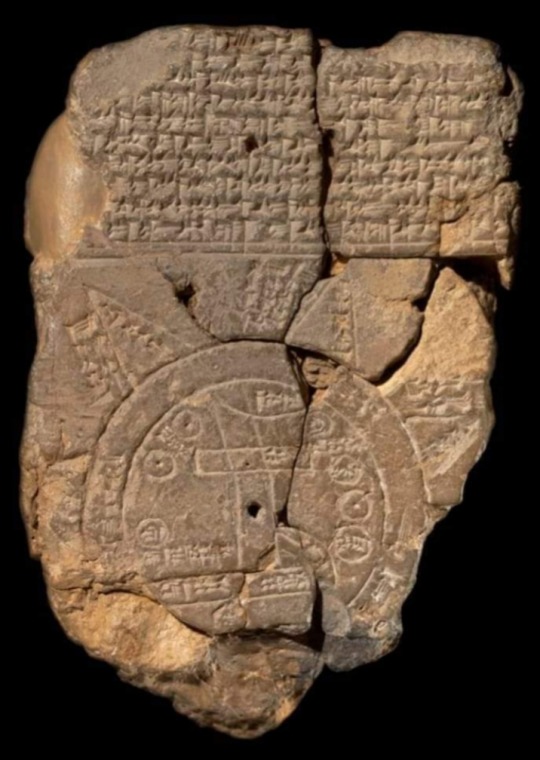
Babylonian Map of the World (6th century BC), also known as Imago Mundi, is oldest clay tablet map written in Akkadian.
The tablet describes the oldest known depiction of the known world.
It was discovered at Sippar, southern Iraq, 60 miles north of Babylon on east bank of Euphrates River.
This map not only serves as a historical record of the region's geography but also includes mythological elements, providing a comprehensive view of the ancient Babylonian worldview.
Today, the Babylonian Map of the World is housed in the British Museum, where it continues to be a valuable artifact for understanding the ancient past.
Details of the map:
1. “Mountain” (Akkadian:šá-du-ú)
2. “City” (Akkadian: uru)
3. Urartu (Armenia) (Akkadian: ú-ra-áš-tu)
4. Assyria (Akkadian: kuraš+šurki)
5. Der (Akkadian: dēr)
6. Swamp (Akkadian: ap–pa–ru)
7. Elam (Akkadian: šuša)
8. Canal (Akkadian: bit-qu)
9. Bit Yakin (Akkadian:bῑt-ia-᾿-ki-nu)
10. “City” (Akkadian: uru)
11. Habban (Akkadian: ha-ab-ban)
12. Babylon (Akkadian: tin.tirki), divided by Euphrates
13. Ocean (salt water, Akkadian:idmar-ra-tum)
#Babylonian Map of the World#Imago Mundi#clay tablet map#clay tablet#Akkadian#Sippar#Iraq#British Museum#history#mythology#map#Archaeo Histories#Ancient Babylon#Babylonia#geography#artifact
564 notes
·
View notes